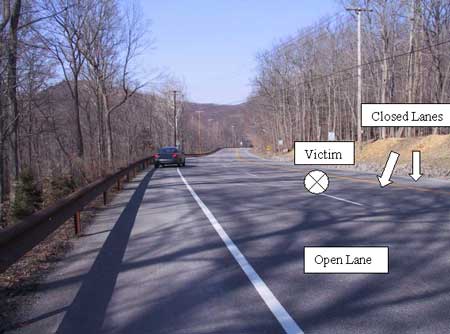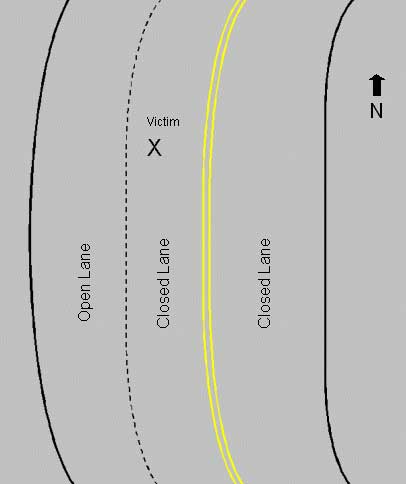Flagger Dies after being Struck by a Pickup Truck in a Highway Work Zone
New York Case Report 04NY012
Summary
On February 20th, 2004 a 47 year-old male flagger, who was employed by a temporary employment service agency, was struck by a pickup truck driven by a traveling motorist in a highway work zone. At the time of the incident, the victim and another flagger were directing traffic on a state highway for a tree service crew that was trimming branches to clear the power lines that belonged to a local utility company. On the morning of the incident, the crew had closed two lanes of a three-lane highway and had left only one southbound driving lane open to all traffic, both northbound and southbound. Warning signs were placed ahead of the work zone at each end. The victim, who wore a reflective vest and a hard hat, was directing the southbound traffic with a “Stop/Slow” sign at the north end of the work zone. At approximately 9:05 a.m., a black pickup truck suddenly pulled out of the southbound traffic into the passing lane and accelerated to approximately 60 miles per hour (mph) into the work zone. The victim was struck by the vehicle and thrown in the air by the impact. He landed on the northbound shoulder approximately 30 feet from the collision point. The emergency squad and the New York State Police (NYSP) arrived at the incident site within minutes. The victim was transported by helicopter to a hospital trauma center where he died thirteen days after the incident from the injuries sustained in the collision. The driver of the pickup truck was arrested for multiple traffic violations.
New York State Fatality Assessment and Control Evaluation (NY FACE) investigators concluded that to help prevent similar incidents from occurring in the future, employers should:
- Consider the use of law enforcement officers in cruisers at each end of highway work zones and the use of radar surveillance for traffic speed control;
- Reduce speed limits through work zones on highways with high traffic volume to help protect workers; and
- Use additional traffic control devices and warning signs to supplement the minimum signs recommended by the Manual on Uniform Traffic Control Devices (MUTCD).
Introduction
On February 20th, 2004, at approximately 9:05 a.m., a 47 year-old male flagger, who was employed by a temporary employment service agency, was struck by a pickup truck driven by a traveling motorist in a highway work zone. At the time of the incident, the victim and another flagger were directing traffic on a state highway for a tree service crew that was trimming branches to clear the power lines that belonged to a local utility company. Both flaggers and the tree service crew were hired by the utility company. The victim died in the hospital on March 4th as a result of the injuries he sustained in the collision. New York State Fatality Assessment and Control Evaluation (NY FACE) staff learned of the incident on March 5th from a newspaper article. On March 23rd, a NY FACE investigator met with the New York State Police (NYSP) investigator who investigated the case. The NYSP investigator accompanied the NY FACE investigator to the incident site to collect information and observe the scene. The flagger who was working with the victim during the incident was interviewed during the course of the investigation. Additional information was collected from representatives of the temporary employment agency, an area office of the federal Occupational Safety and Health Administration (OSHA), and the medical examiner’s office.
The victim completed a flagger training course provided by the National Safety Council through the temporary employment service agency and became a certified flagger in January of 2004. According to the employment agency representative, the agency discussed general flagging safety with the flaggers, while worksite host employers at each specific site were responsible for site-specific safety. The employment agency issued the following personal protective equipment to the flaggers: ANSI certified reflective vests and hard hats.
Back to Top
Investigation
The incident occurred on a major state highway that runs south to north from New York City to the New York State border with Canada. A local utility company contracted a tree service firm to trim branches and cut brush along the power lines adjacent to the highway. Two flaggers were hired from a temporary employment agency to direct traffic at the work site. The section where the tree trimming was taking place was a three-lane highway with one northbound and two southbound lanes. A double yellow line demarcated the northbound and southbound lanes. There was a solid white line on both sides of the highway and a dashed white line delineating the two southbound lanes. The roadway curved toward the east at both ends of the work zone. The speed limit in the area of the incident was 50 mph.
The work force consisted of a groundsman and a foreman, both from the tree service firm, and the victim and another flagger from the temporary employment agency. There were no personnel from the local utility company present at the work site at the time of the incident. According to the employment agency and the flagger who was on site on the day of the incident, the foreman was in charge of the work zone. He oversaw the tree trimming operation and coordinated with the flaggers. The foreman was also responsible for placing the traffic warning signs and traffic safety cones to channel the traffic and demarcate the work zone.
On the morning of the incident, the victim and the other flagger reported to the foreman at the work site at approximately 7:30 a.m. The crew worked on the east side of the highway. They closed two of the three lanes, leaving only one southbound driving lane open to all traffic, both northbound and southbound (Figures 1 and 2). The work zone was approximately 300 feet long. Three warning signs were placed ahead of the work zone at each end including a “flagger”, a “man working”, and a “one lane road” sign. At the north end of the zone where the victim was stationed, the warning signs were placed approximately one-half mile north of the collision point. On the day of the incident, there was no inclement weather recorded in the area, and the road condition was fair according to the witness.
 |
|
Figure 1. Incident site including lane closures and victim’s position.
|
At the time of the incident, the victim was standing at the north end of the work zone in the closed southbound passing lane behind a line of traffic cones. He was directing the flow of the southbound traffic with a “Stop/Slow” sign. The victim communicated visually with the other flagger at the south end of the work zone. At approximately 9:05 a.m., the southbound traffic was slowly approaching the work zone. According to the traveling motorists who witnessed the incident, a black Ford F350 Super Duty Pickup truck suddenly pulled out of the traffic into the closed passing lane. The vehicle passed several vehicles that had slowed down in the open driving lane, and accelerated into the work zone. The victim ran towards the northbound lane to avoid the rapidly approaching vehicle. According to the NYSP collision reconstruction report, the pickup truck began braking at this point and then swerved into the northbound lane and struck the victim. The reconstruction report calculated the minimum speed of the vehicle at the time of the collision as approximately 58.20 mph. The victim was thrown in the air by the impact and landed on the northbound shoulder approximately 30 feet from the collision point. A NYSP investigator happened to be traveling in the southbound traffic and witnessed the incident. He immediately called 911 and informed the state police. The emergency squad and NYSP arrived within minutes. The victim was taken to a hospital trauma center where he died on March 4th from the injuries sustained in the collision. The driver of the pickup truck was arrested for multiple traffic violations. NYSP tests of the driver for alcohol and drugs were negative.
Back to Top
Cause of Death
The cause of death was listed on the death certificate as fractures of extremities and pelvis; laceration of scalp and subdural hematoma; splenic and mesenteric injuries (clinical); survival of 2 weeks with anoxic encephalopathy and sepsis.
Back to Top
Recommendations/Discussion
Recommendation #1: Employers should consider the use of law enforcement officers in cruisers at each end of large highway work zones and the use of radar surveillance for traffic speed control.
Discussion: The presence of law enforcement and use of radar surveillance during active work periods would help to maintain traffic speeds at or below the posted speed limit.
Recommendation #2: Reduce speed limits through work zones on highways with high traffic volume to help protect workers.
Discussion: In this case, the posted speed limit was 50 mph through the work zone where there was only one lane open to the traffic. The speed limits in work zones that are in highways with high volume of traffic should be reduced. Vehicles traveling at lower speeds can give both motorists and workers longer time to react when responding to imminent danger, thereby enhancing workers’ safety in highway work zones.
Recommendation #3: Employers and highway work crews (contractors) should consider using additional traffic control devices and warning signs to supplement the minimum signs recommended by the Manual on Uniform Traffic Control Devices (MUTCD).
Discussion: The MUTCD sets forth the basic principles and minimum standards governing the design and use of traffic control signs and devices. Employers should consider using additional traffic control devices to supplement the minimum signs and/or devices recommended by MUTCD. For example, rumble strips provide a vibratory and audible warning in addition to visual stimuli, and speed bumps can physically slow down traffic. Supplemental signs showing distances in feet to the work zone ahead and the flagger’s position may alert and prepare motorists to slow down or stop when they approach the work zone.

|
|
Figure 2. Diagram of Incident.
Locations are not exact and diagram not drawn to scale. |
Back to Top
References
- NIOSH FACE Report 2000-02
https://www.cdc.gov/niosh/face/In-house/full200002.html - Manual on Uniform Traffic Control Devices (MUTCD)
http://mutcd.fhwa.dot.gov/external icon
New York FACE Program
The Fatality Assessment and Control (FACE) program is one of many workplace health and safety programs administered by the New York State Department of Health (NYS DOH). It is a research program designed to identify and study fatal occupational injuries. Under a cooperative agreement with the National Institute for Occupational Safety and Health (NIOSH), the NYS DOH FACE program collects information on occupational fatalities in New York State (excluding New York City) and targets specific types of fatalities for evaluation. NYS FACE investigators evaluate information from multiple sources. Findings are summarized in narrative reports that include recommendations for preventing similar events in the future. These recommendations are distributed to employers, workers, and other organizations interested in promoting workplace safety. The FACE program does not determine fault or legal liability associated with a fatal incident. Names of employers, victims and/or witnesses are not included in written investigative reports or other databases to protect the confidentiality of those who voluntarily participate in the program.
To contact New York State FACE program personnel regarding State-based FACE reports, please use information listed on the Contact Sheet on the NIOSH FACE web site. Please contact In-house FACE program personnel regarding In-house FACE reports and to gain assistance when State-FACE program personnel cannot be reached.
